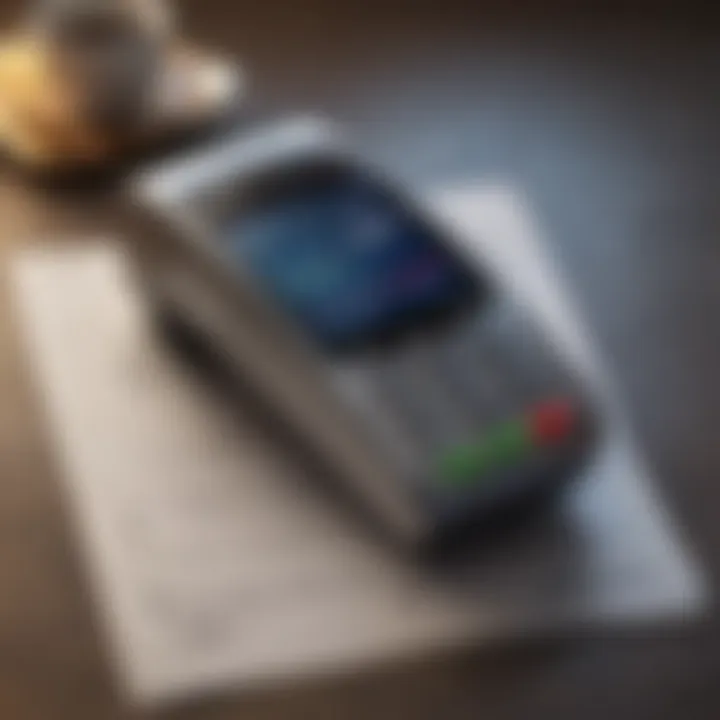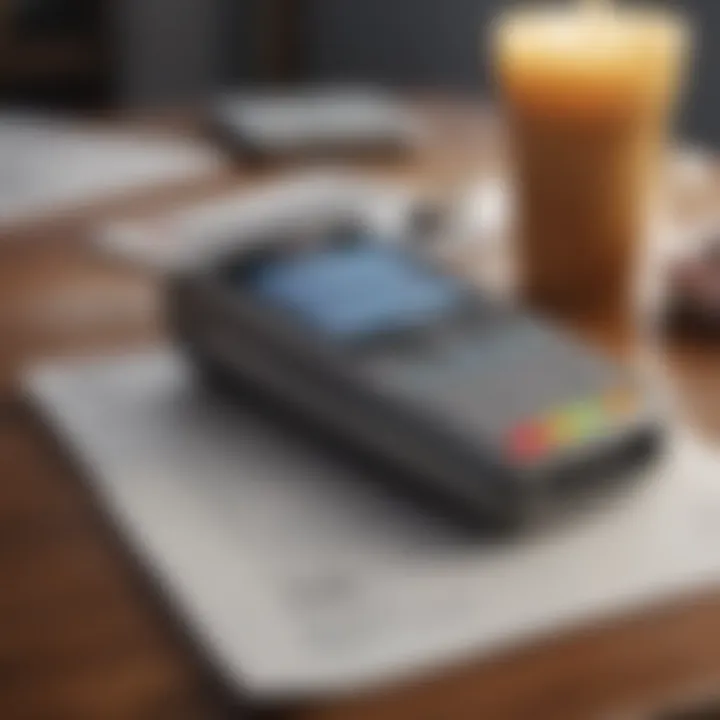Understanding Mobile Bill Pay: A Complete Overview


Intro
In our fast-paced lives, staying on top of finances is essential. Mobile bill pay has emerged as a vital tool for young professionals, students, and small business owners, offering a way to manage expenses with just a few taps on a smartphone. This guide explores the ins and outs of mobile bill payments, helping readers gain a nuanced understanding of how this technology works, its benefits, and potential drawbacks.
Whether you're juggling multiple subscriptions or just trying to keep the lights on, integrating mobile payment into your routine can offer a practical solution. So, let’s kick things off by diving into some financial concepts that lay the groundwork for understanding mobile bill pay better.
Prolusion to Mobil Bill Pay
The advent of mobile technology has transformed the way we manage our finances. Enter Mobil Bill Pay, a service seemingly crafted for the fast-paced lives we lead. This article will unfold the significance of this service, breaking down its utility, challenges, and everything in between to give you a well-rounded grasp.
What is Mobil Bill Pay?
Mobil Bill Pay is a feature that allows users to pay bills via their smartphones. Think of it as a quick tap here and there, instead of riffling through physical bills or logging into a website on a computer. Most mobile bank applications provide this service, linking directly to bank accounts, credit cards, or even digital wallets like PayPal. It makes life significantly easier, whether you're tapping your phone to pay a utility bill or settling a medical expense.
But what sets Mobil Bill Pay apart is its ability to aggregate numerous bills in one place. No more wondering where that pesky cable bill went – everything is organized on your device, and reminders can be set to keep you on track.
The Importance of Mobile Payments
Understanding the importance of Mobil Bill Pay starts with recognizing a shift towards digital payments in general. More people are moving away from cash in favor of a mobile wallet – studies have shown a growth in users opting for mobile payments across different demographics.
"The convenience of paying bills on the go is undeniable, and it fits perfectly into the busy lives of young professionals and families."
The importance lies not just in ease but also in security. Many mobile payment apps have robust encryption protocols, providing an added layer of safety. Users can also track their spending habits better, which contributes to smarter financial management. When every penny can be monitored straight from your pocket, financial literacy comes easier, trickling down into making informed decisions for future expenditures.
In essence, Mobil Bill Pay isn't just a convenience; it's a tool that fosters responsible financial behavior, ensures timely payments, and reduces the stress that often accompanies managing bills. As we carry on, we’ll delve deeper into how this system works and explore its benefits and potential drawbacks.
How Mobil Bill Pay Works
Understanding how mobile bill pay functions is key to appreciating its role in modern financial management. This section dives into the intricacies of payment processing and the seamless integration with banking services, elucidating why it matters in today’s fast-paced world.
The Process of Making Payments
At its core, making a payment through a mobile bill pay system can be summed up as a straightforward process, but there are multiple layers involved. First, a user initiates the payment by logging into their mobil payment platform, often via an app or a website. They enter the amount to be paid and select the recipient from their saved contacts or by inputting their details manually.
Next comes the confirmation step, where the user reviews the transaction details before finalizing it. This is crucial, as a hasty mistake could lead to paying the wrong bill. Once confirmed, the payment is processed electronically. The transfer takes place almost instantaneously in most cases, although the actual posting to the recipient's account may vary by financial institution.
A notable feature often found within many mobile bill pay systems is the option to set up recurring payments. This is beneficial for bills that remain constant, ensuring that payments are never missed while saving the hassle of logging in repeatedly. In practical terms, someone managing household utilities might find joy in automating these payments every month, prioritizing their time for what really counts.
Integration with Banking Services
The integration of mobil bill pay with banking services lays the foundation for its efficiency and simplicity. Most major banks have adopted features that allow users to manage payments directly through their banking apps. This not only consolidates financial management into one platform but also enhances the trust factor for users who may be hesitant about using third-party services.
Linking a bank account to a mobile bill payment system generally involves secure authentication methods such as multi-factor authentication. This adds an extra layer of safety since customers are prompted to verify their identity before any transactions can be made.
Moreover, the integration makes it much easier for users to keep an eye on their financial health. Users can monitor their spending patterns, observe which bills are almost due, and ensure they maintain a balanced budget. With the records of payments available at their fingertips, budgeting becomes less of a chore and more of a routine.
This seamless connectivity transforms the way individuals and small business owners handle their finances, making budgeting more manageable and paving the way for financial accountability.
"The easier you make paying bills, the more likely it is to get done on time, which is crucial for maintaining a healthy financial profile."
With these elements in play, it’s clear that understanding how mobile bill pay works is not just about the mechanics of payment. It's about leveraging this technology to enhance financial stability, accessibility, and security.
Benefits of Mobil Bill Pay
Mobile bill pay is more than just a technological advancement; it's a transformative means of handling finances that resonates particularly well with today’s fast-paced lifestyles. This section unpacks the multifaceted advantages of utilizing mobile bill payment systems, especially important for young professionals, students, and small business owners who are balancing tight schedules with numerous obligations.


Convenience and Accessibility
The modern consumer operates in an environment where convenience is paramount. With mobile bill pay, users can manage their payments anytime, anywhere, using their smartphones or tablets. Imagine being able to pay your utilities while waiting for your coffee to brew in the morning, or settling your subscription fees while taking a break at work. This level of accessibility cuts down significantly on the time spent sorting through bills or finding an appropriate moment to make payments.
Moreover, the intuitive nature of many mobile payment apps makes the process straightforward, even for those who may not be tech-savvy. All it takes is a few taps on the screen. Many applications also support biometric options like fingerprint or facial recognition, enhancing both convenience and security. The ease of use is further magnified by the fact that these platforms typically compile multiple bills into one cohesive dashboard, fostering seamless navigation through financial obligations.
Time Efficiency
In our busy lives, every second counts. Mobile bill payment allows users to optimize their time management. Payments that traditionally would consume valuable minutes can now be executed in a fraction of that time. The average person might spend upwards of 10 minutes physically writing checks or navigating through online banking platforms, but mobile options can condense that down to a mere few taps, saving precious time.
Additionally, automated bill payment features embedded in many mobile applications further enhance this efficiency. Setting up recurring payments for fixed bills helps users avoid late fees and penalties. For example, a small business owner can automate monthly rent and service fees, freeing up cognitive resources to focus on growing their business instead of worrying about due dates or late payments.
Enhanced Financial Tracking
One overlooked aspect of mobile bill payments is the beneficial impact on financial tracking. Tracking spending habits and payment history becomes a cinch with integrated finance management features many applications provide. Users can visualize their financial inflows and outflows, making it easier to identify spending trends and adjust their budgets accordingly.
For instance, features like spending alerts and budgeting tools within these platforms can serve as wake-up calls for overspending or changes in financial habits. This kind of granularity was often lost in traditional banking practices where paper trails and long statements could easily confuse one’s financial situation. By graphically displaying account performance and providing tangible insights, mobile payments empower users to take charge of their finances like never before.
"Mobile payment revolutionizes how we interact with our finances and helps us stay on track efficiently."
In summary, the benefits of mobile bill pay encompass convenience, time savings, and a substantial boost to financial awareness. Individuals investing in this technology are not merely adopting a new method of payment, but they are embracing a smarter, more connected way to manage their money.
Potential Drawbacks of Mobil Bill Pay
While the convenience of mobile bill pay can hardly be overstated, it's equally vital to acknowledge that this system is not without its complications. As with any technological advancement, there are potential drawbacks that might affect users differently. Understanding these elements helps consumers make informed decisions that align with their financial habits and needs.
Security Concerns
When engaging with mobile bill pay, the specter of security should always be looming large. While many payment platforms implement strong encryption protocols to safeguard user data, no system can be guaranteed entirely impervious to cyber threats. Users who store sensitive information, such as bank account numbers or credit card details, might find themselves vulnerable to hacking or data breaches.
For instance, take a situation where a user receives a phishing email that appears to come from their payment app. If they mistakenly enter their login info on a fraudulent site, the consequences could be dire. Always double-check the URLs and be cautious with unsolicited requests for personal information. Additionally, enabling multifactor authentication on accounts could act as a safety net, adding another layer of protection.
"Being cautious online is like keeping your doors locked at night; it’s a simple but essential practice."
Technology Dependence
In our fast-paced digital age, being tethered to technology is as common as morning coffee. However, this reliance on mobile bill payments often raises questions about accessibility. Not everyone has a reliable smartphone or internet connection, which can pose a challenge in managing finances on the go.
Furthermore, outages or app malfunctions could lead to missed payments and potential late fees, creating unnecessary stress for users. In extreme cases, if a user loses their phone or it gets damaged, accessing payment services can become quite a hassle. The consequence? Financial slip-ups that could easily be avoided. So, it might be prudent to keep backup options, such as traditional bill pay methods, in your toolkit.
Hidden Fees and Charges
Hidden fees can sometimes feel like the proverbial spider in the web, lurking in the corners of any financial transaction. Many users are surprised to discover that their seemingly straightforward mobile bill payment services may come with strings attached. Certain apps or services might impose extra charges for expedited payments or transactions made through credit cards as opposed to debit cards.
It's essential to scrutinize the terms of service closely before committing to any mobile payment platform. Some fees may seem minimal at first glance but can quickly accumulate over time, thereby offsetting the cost-effectiveness that mobile bill pay promises.
To avoid falling into this trap:
- Always review payment platforms carefully.
- Look for transparent fee structures.
- Compare options to find the most economical choice.
Understanding these potential drawbacks equips consumers to use mobile bill pay wisely, balancing convenience with caution. In a rapidly evolving payment landscape, being savvy about one's choices can make all the difference in maintaining financial wellness.
Different Platforms for Mobil Bill Pay
As mobile payments have become a cornerstone of personal finance, having the right platform can significantly influence your experience and efficiency. Each option on the market offers unique capabilities and conveniences, making it essential to understand what’s out there. From dedicated apps to banking services and third-party solutions, exploring different platforms allows users to find the most suitable means of managing their bills with ease. This section discusses popular platforms for mobile bill payment and delves into their specific features, advantages, and what to keep in mind.
Mobile Apps for Bill Payments


Mobile applications designed explicitly for bill payments are some of the front runners when we talk about convenience. These apps cater to various needs and often boast user-friendly interfaces. Some popular choices include PayPal, Venmo, and Square Cash. These platforms let users pay bills electronically without the hassle of writing checks or making bank trips.
- User Experience: Since most people carry their phones everywhere, these mobile apps make it easy to manage bills on the go. Whether at home or with friends, payments can be completed in just a few taps.
- Automation Features: Many of these apps also allow you to set up automatic payments, which eliminates the worry of late fees.
- Alert System: Notifications can remind you of upcoming payments and due dates, adding another layer of convenience.
However, picking the right app shouldn't be done on a whim. Different apps come with varying transaction fees and transfer times, so a little homework goes a long way in ensuring you pick the one with the best deal.
Banking Services with Mobil Payment Features
Many banks have integrated mobile payment features into their services, allowing users to manage payments through well-known banking apps. Banks like Wells Fargo, Chase, and Bank of America have put substantial resources into enhancing customer experience through their mobile platforms.
- Seamless Integration: Using the same app for both banking and payments can make financial management more straightforward. Users can view their balance, manage bills, and handle transfers in a single platform.
- Security Measures: Banks typically have established security protocols that ensure a higher level of protection for their customers. Encryption and fraud detection systems are often part and parcel of these services.
- Comprehensive Management: This consolidation of services aids users in better tracking their spending habits and managing budgets.
That said, not all banking apps are created equal. Some may offer limited bill payment options or may not connect with several service providers, so a comparison is worthwhile.
Third-Party Payment Solutions
Third-party payment solutions like Zelle, Stripe, or Apple Pay are increasingly becoming the preferred method for many users. These platforms act as middlemen between your bank and the service you’re paying, often streamlining the process.
- Flexibility: They generally support multiple payment methods, allowing users to link various bank accounts or credit cards, making it easy to find what suits each bill best.
- Broader Acceptance: Often, these solutions are widely accepted across various merchants. This can be useful when paying for services that may not be covered by traditional bank apps or localized services.
- Speed: Payments can often be processed quicker compared to traditional methods, with many offering instant transfer capabilities.
Still, one must tread carefully when choosing third-party applications. Considering factors like transaction fees, user experience, and customer support can save you from future hassles.
Ultimately, the platform you choose for mobile bill pay can significantly shape your experience. Having options like dedicated apps, integrated banking services, or versatile third-party solutions fosters an environment where managing your finances is easier than ever before.
Integrating Mobil Bill Pay into Financial Management
Integrating mobile bill pay into one's financial management can transform the way individuals and families handle their expenses. In an age where time is money, efficiency in payment processes not only simplifies life but can also contribute to smarter financial decisions. Recognizing the immense advantages of this integration is crucial, especially for young professionals, students, and small business owners who juggle multiple responsibilities. Leveraging mobile bill payment services effectively can lead to better budgeting, quicker payment resolution, and enhanced tracking of expenses, ultimately fostering a healthier financial lifestyle.
Setting Up a Mobil Bill Pay Account
Setting up a mobile bill pay account can be a straightforward process, yet it requires thoughtful consideration. First and foremost, it’s essential to choose a platform that suits personal needs. Popular options like PayPal, Venmo, and various banking apps cater to diverse preferences.
Once a method is decided, users typically need to provide some basic details, such as personal identification and banking information. Security is paramount; thus, ensuring that the platform utilizes robust encryption and validates transactions is crucial. Here’s a simple step-by-step breakdown to guide the setup:
- Download the App or Access the Website: Begin by downloading the desired app or navigating to its online platform.
- Create an Account: Fill in required information, including name, email address, and selected payment method.
- Verify Your Identity: Identify verification may involve confirming an email or entering a code sent to your phone.
- Link Your Bank Account or Card: Input banking details, making sure to follow the guidelines for security.
- Familiarize Yourself with Features: Spend some time exploring the app’s functionalities, such as scheduling payments and reviewing transaction history.
With these steps, users can quickly access their accounts and start managing their bills more effectively.
Budgeting with Mobil Bill Pay
Budgeting is a critical part of financial management. With mobile bill pay, budgeting becomes less of a chore and more of an effortless task integrated into routine habits. Users can set up reminders for upcoming payments and categorize expenses, lending clarity to where their money goes.
To maximize budgeting effectiveness:
- Create a Monthly Budget: Identify fixed and variable expenses. Breaking these down can help visualize total costs.
- Use App Features: Many mobile bill pay services offer budgeting tools. Utilizing these can track payments and provide insights on spending habits.
- Set Spending Limits: Apportion budgets to different categories, like groceries, entertainment, and savings. Enforcing limits encourages better financial discipline.
By streamlining budgeting processes through mobile bill pay, individuals can sidestep the headaches of overspending and maintain a focused view on their financial goals.
Tracking Payments and Expenses
Tracking payments and expenses is crucial for understanding one’s financial health. With mobile bill pay, this is simplified dramatically. Users can easily check payment histories within their chosen app, which presents a straightforward way to monitor expenses over time.
To effectively track payments:
- Regularly Review Transactions: Set aside a dedicated time each week to analyze payment activity. This aids in recognizing patterns or irregular expenses that may surface.
- Utilize Reports and Analytics: Some apps provide visual representations of spending. Leverage these insights to adjust strategies for future spending.
- Always Reconcile with Bank Statements: Ensure the records align with bank statements. This prevents surprises in monthly budgets and detects any discrepancies early on.


Tracking becomes less of a burden and a powerful tool for maintaining healthy finances. With the right approach, integrating mobile bill pay into daily routines can lead to well-managed finances, where each dollar served its purpose efficiently.
Best Practices for Safeguarding Your Information
In the realm of mobil bill pay, ensuring the safety of your financial data is of utmost importance. Not only do you want to utilize the convenience of technology, but you also wish to protect yourself from potential threats. This section provides critical insights on how to navigate the digital landscape securely while enjoying the benefits of mobile payments.
Choosing Secure Platforms
When it comes to using mobil bill pay, the choice of platform is pivotal. Not all apps and services are created equal, so investing time in this step can save you a world of headache down the line.
Here are a few key factors to consider:
- Research Reviews and Ratings: Before downloading an app, check what other users have to say. Read reviews from credible sources, rather than just browsing the app store. If many users mention security issues or bugs, it might be wise to steer clear.
- Look for Encryption: Ensure that the payment platform employs strong encryption methods. This secures your data as it travels between your device and their servers. Ask yourself – do they mention encryption protocols in their policy? If not, walk away.
- Read Privacy Policies: It might be a nuisance, but scanning through privacy policies helps you understand how platforms handle your data. Look for transparency in how they store, use, or share your information.
- Check for Authentication Features: Safe platforms often offer two-factor authentication or biometric login options. If the option exists, definitely enable these features to add an extra layer of security.
Regularly Updating Passwords
Your password is your first line of defense against unauthorized access to your accounts. Regularly updating your password might sound tedious, but it is a simple yet effective measure to mitigate potential threats.
- Schedule Regular Reminders: It can be easy to forget about this practice in the hustle of day-to-day life. Setting calendar reminders every few months ensures this isn't overlooked.
- Create Unique Passwords: It is tempting to use the same password across multiple accounts for convenience. However, this is a grave mistake. Each platform should have a unique password to reduce risk.
- Use Password Managers: If keeping track of unique passwords feels overwhelming, consider using a password manager. These tools securely store and generate complex passwords, so you don’t have to sweat remembering them all.
- Test Password Strength: Regularly check how strong your passwords are. There are free tools online that evaluate the strength of your passwords and suggest improvements.
- Avoid Common Words and Simple Patterns: Using something like “12345678” or your pet’s name might be easy for you to remember, but it’s also easy for others to guess. Create a passphrase – a mix of unrelated words, numbers, and symbols to maximize security.
Important Note: Always be vigilant and trust your instincts. If something seems off in your transactions or if the app suddenly behaves strangely, it’s better to err on the side of caution and investigate further or change your passwords immediately.
Future Trends in Mobil Bill Pay
The landscape of mobile bill payments is constantly shifting, shaped by emerging technologies and evolving consumer preferences. A deep dive into Future Trends in Mobil Bill Pay reveals how these developments not only enhance user experiences but also introduce new opportunities for businesses and individuals alike. As we step further into this digital age, understanding these trends becomes crucial for maximizing the advantages of mobile payments.
Advancements in Payment Technologies
In the realm of mobile payments, the technological wheels are turning faster than ever. New advancements are paving the way for smoother transactions and increased convenience. One such change is the introduction of biometric authentication, such as fingerprint and facial recognition. These methods offer a layer of security that reassures users and minimizes the risk of fraud.
Moreover, the utilization of artificial intelligence in transaction monitoring means that chances of unauthorized access are significantly reduced. AI tools analyze spending habits and flag any anomalies in real-time, providing a strong defense against fraudulent activities.
The proliferation of Near Field Communication (NFC) technology also marks a significant milestone. NFC allows for effortless payment through a simple tap of a mobile device on a terminal. This feature is particularly appealing to time-strapped consumers who prefer quick, efficient payment methods. It's not just cash that’s become a thing of the past; contactless payment methods are redefining how everyday transactions happen.
"Technology is not just changing payment methods; it's reshaping our relationship with money."
Other futuristic concepts, like blockchain technology, are gaining traction as well. By facilitating peer-to-peer transactions without going through traditional banks, blockchain promises to streamline processes and reduce costs. This can lead to faster settlements and expanded access to financial services.
The Rise of Digital Wallets
Digital wallets have emerged as a pivotal player in the mobile bill pay ecosystem. These tools consolidate various cards, accounts, and payment options into one user-friendly platform. Instead of juggling between multiple apps or platforms, consumers find it easier to manage their finances from a single interface.
The popularity of platforms like Apple Pay, Google Pay, and PayPal is undeniable. These services not only support diverse payment options but also integrate loyalty programs and promotional offers. Young professionals and students especially appreciate this added layer of convenience, as they can earn points or discounts effortlessly while making payments.
While the uptake of digital wallets is commendable, there are some considerations to keep in mind. For instance, users must remain vigilant about their security settings and be cautious about shared devices where their wallets might be accessed.
Nevertheless, the adaptability of these wallets continues to attract users. As more businesses embrace these systems, consumers can expect a wider acceptance range, simplifying the payment process across various sectors, from retail to services.
In summary, the Future Trends in Mobil Bill Pay hold both exciting advancements and substantial considerations. By keeping abreast of these dynamics, individuals can make informed decisions about their payment methods, while businesses can leverage these trends to stay ahead in a competitive marketplace.
End
In wrapping up our exploration of Mobil Bill Pay, it's vital to recognize how crucial this tool has become in our daily financial dealings. As we traverse through a fast-paced world that demands immediacy, understanding the ins and outs of mobile bill payment systems can bring substantial benefits to our lives.
Reflecting on Mobil Bill Pay
First off, let’s reflect on the growing reliance we have on mobile payments. Today, many people juggle numerous bills—from utilities to subscriptions—often in a pinch. Mobil Bill Pay serves as a lifebuoy in this chaos, allowing users to streamline the process. Whether it's a breeze to pay that pesky electricity bill while sipping coffee or ensuring your rent is in the bank before the deadline, the portable nature of mobile payments means you’re seldom tied to a desk or a checkbook.
Moreover, this approach fosters discipline in personal finance management. With most platforms providing notification reminders and tracking capabilities, users can develop better payment habits, reducing the likelihood of late fees or missed deadlines. It's like having a financial advisor in your pocket, nudging you just at the right moments.
Final Thoughts on Usage and Future Potential
The landscape of payments is shifting beneath our feet, and Mobil Bill Pay is right at the forefront of that change. Looking into the crystal ball, one can’t help but wonder about the innovations on the horizon. As technology continues to evolve, we might see even greater advancements in security measures and user interfaces.
But it’s not just about safety—it’s also about inclusivity. As digital wallets gain traction, there’s potential to reach demographics previously sidelined by traditional banking methods. Imagine a world where managing finance via mobile becomes common, making financial services more accessible to everyone.







